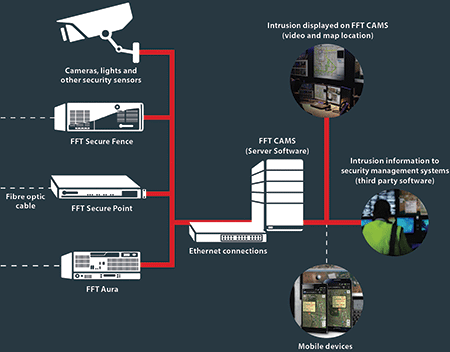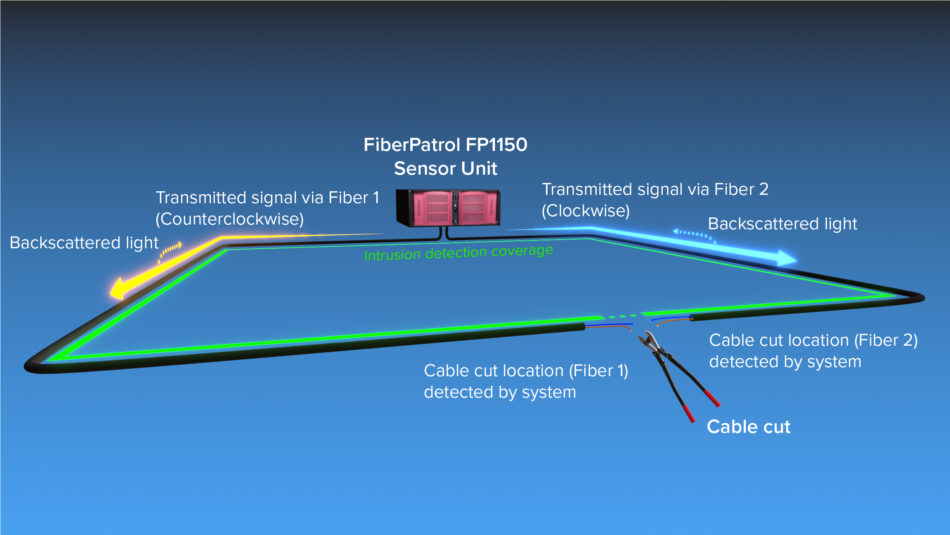A Comprehensive Guide to Fiber Optics Infrastructure for Security Installations
A Comprehensive Guide to Fiber Optics Infrastructure for Security Installations
Blog Article
Why Fiber Optic Security Solutions Are the Future of Security
The change to fiber optic security systems marks a significant development in the realm of security, driven by their outstanding information transmission capacities and strength to exterior disturbances. As the landscape of protection evolves alongside emerging technologies such as AI and IoT, the potential for fiber optics to enhance and redefine safety and security facilities comes to be increasingly apparent.
Advantages of Fiber Optic Solutions
Among the key benefits of fiber optic systems is their exceptional data transfer capacity, which facilitates the transmission of big volumes of information over fars away without substantial loss. This characteristic is specifically helpful for security applications that need the continual monitoring and transfer of high-def video clip feeds, sensing unit information, and other important information. Optical fiber can fit the expanding demands of modern safety and security systems, ensuring that information continues to be undamaged and reputable.
In addition, fiber optic cords are much less vulnerable to electromagnetic disturbance, which can be a substantial problem in atmospheres with various electronic tools. This resistance enhances the honesty of the information being transferred, consequently reducing the threat of data violations or system failures. Additionally, fiber optic systems are naturally much more secure than typical copper cable televisions, as touching into a fiber optic line without discovery is exceedingly hard.
The longevity of fiber optic cable televisions additionally adds to their appeal. They are immune to ecological elements such as wetness and temperature variations, decreasing upkeep prices and increasing system durability. On the whole, these benefits position fiber optic systems as a robust and effective selection for modern-day safety and security frameworks, ensuring trustworthy and safe and secure data transmission.
Enhanced Data Transmission Speed

The capacity to transmit vast amounts of data swiftly promotes the seamless combination of high-def video clip feeds and advanced analytics. Safety systems can currently process and examine details in real-time, boosting response times and situational awareness. Furthermore, fiber optic links sustain longer transmission distances without deterioration of signal quality, making them suitable for large security networks.
The raised speed of fiber optic systems not only enhances the effectiveness of safety and security procedures yet likewise minimizes latency. This is especially crucial in vital situations where timely decision-making can prevent security breaches or minimize possible dangers. As companies remain to prioritize safety and performance, the need for quick and reputable data transmission will certainly solidify fiber optic systems as a keystone of contemporary safety infrastructure.
Resistance to Interference
Fiber optic protection systems constantly demonstrate remarkable resistance to electro-magnetic disturbance, an important advantage in settings vulnerable to digital noise. Unlike traditional copper wires, which can be adversely impacted by magnetic fields, radio regularity interference, and various other kinds of electric disturbance, fiber optic cable televisions use light to transmit information. This intrinsic residential or commercial property ensures that the signals remain clear and unaltered, no matter surrounding digital task.
Using glass or plastic fibers in fiber optic modern technology produces an obstacle against disturbance, allowing for trusted data transmission also in challenging situations such as industrial centers, urban locations with high digital web traffic, or areas near radio towers. This characteristic significantly minimizes the likelihood of signal deterioration or loss, making fiber optic systems specifically suitable for protection applications where integrity and precision of information are vital.
In addition, this resistance to interference improves the total performance and dependability of protection systems, making certain that monitoring and alert systems work perfectly. In a world where safety is significantly endangered by innovative technologies, the resilience of fiber optic systems attracts attention as a critical function, strengthening their standing as an important element of contemporary safety framework.
Cost-Effectiveness With Time
Substantial cost savings can be achieved over time with the implementation of fiber optic security systems. While the initial investment may appear greater contrasted to typical copper-based systems, the lasting economic advantages come to be noticeable via minimized functional and maintenance costs (fiber security). Fiber optic cable televisions are inherently more durable and much less prone to ecological elements, which translates to lower substitute and repair service click resources costs over their life expectancy
Moreover, fiber optic systems need less power to operate, which further reduces energy his comment is here expenses. Boosted data transmission capacities permit less repeaters and amplifiers, reducing tools investment and simplifying setup procedures. The scalability of these systems also adds to cost-effectiveness, as organizations can broaden their security facilities without sustaining significant extra expenditures.
One more aspect to consider is the enhanced performance in monitoring and action capacities that fiber optics give. Enhanced real-time information transmission can lead to quicker occurrence feedback times, potentially mitigating losses and obligations related to safety and security violations. Altogether, the lasting advantages of fiber optic safety systems not only warrant the initial expenditure yet additionally position them as a financially prudent selection for organizations seeking robust defense services.

Future Technologies in Protection
Progressing modern technologies are established to reinvent security systems, integrating expert system (AI) and machine discovering to boost hazard detection and reaction abilities. These advancements will certainly permit security systems to evaluate huge quantities of index information in real-time, recognizing patterns and abnormalities that show potential threats. This proactive method will allow quicker decision-making and extra reliable case responses.
Additionally, the incorporation of the Internet of Things (IoT) is leading the way for interconnected security devices, providing extensive monitoring and tracking. Smart sensors can communicate info about environmental changes, while automated alerts can notify security personnel right away of questionable tasks.
Additionally, the development of biometric innovations will even more bolster security devices. Face acknowledgment, fingerprint scanning, and retina identification are becoming extra advanced, offering layers of authentication that are difficult to bypass.
Verdict
In final thought, fiber optic safety systems represent a significant advancement in protection modern technology, using unmatched information transmission speed, resistance to electro-magnetic interference, and long-term cost-effectiveness. As the need for sophisticated protection remedies remains to expand, the assimilation of fiber optics with arising innovations such as AI, IoT, and biometrics will additionally improve security frameworks (fiber security). The combination of these innovations will certainly ensure an extra safe and secure and receptive atmosphere, strengthening optical fiber as a foundation of future safety and security systems
Report this page